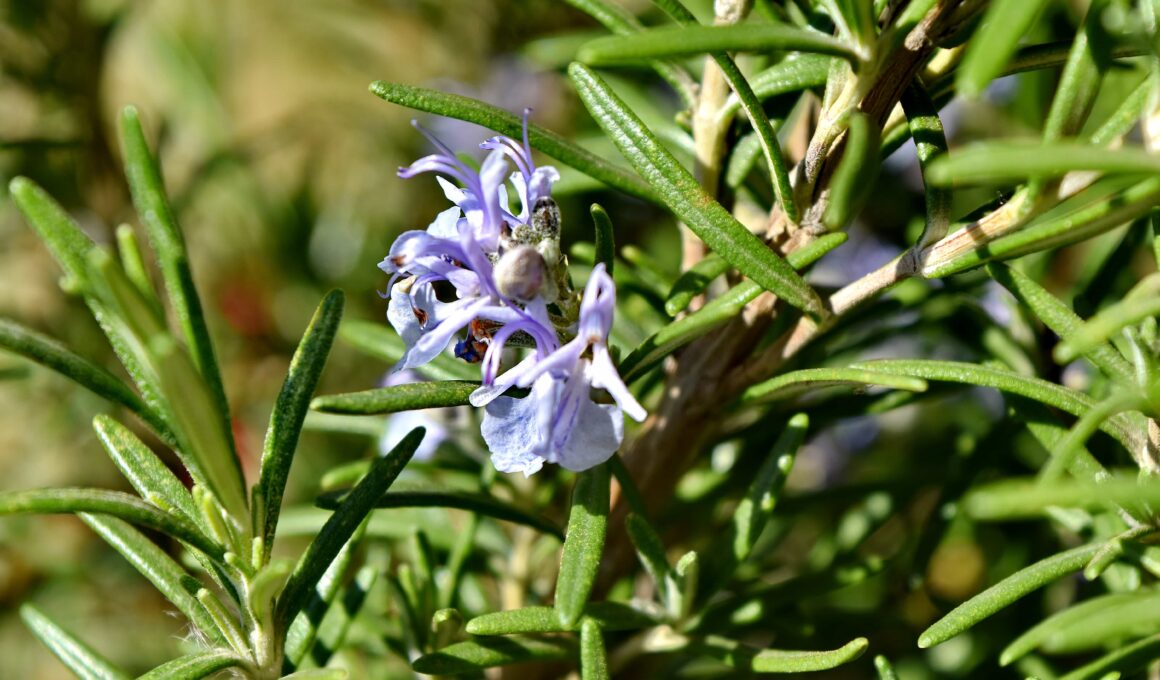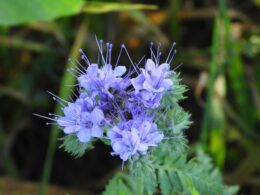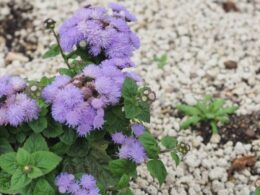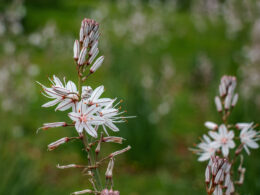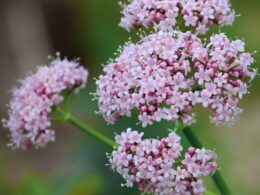In this post, we’ll discuss some of the things that you can do with a rosemary flower plant in your garden, as well as how to take care of it. So, if you’re interested in learning more about rosemary plants, keep reading!
Rosemary Flower: Morphology
Rosemary flower is an evergreen shrub that can grow to between 1 and 6 feet in height. It has narrow, leathery leaves that are dark green and have a strong, pungent aroma. The flowers of the rosemary plant are small and delicate, with a five-lobed white or pale blue corolla. The calyx is green and tubular, and the stamens are arranged in a ring around the pistil. The blue flowers are borne in clusters at the ends of the stems. Rosemary is native to the Mediterranean region and is cultivated all over the world.
Rosemary is a member of the mint family, which includes other aromatic herbs such as basil, oregano, and thyme. The Latin name for rosemary, Rosmarinus officinalis, means “dew of the sea,” and it is thought that the herb got its name because it often grows near the coast in rocky, sandy soil.
Rosemary has a long history of use in folk medicine and is still used today for its purported health benefits. Some people take rosemary supplements to improve memory or concentration, while others apply it topically to relieve muscle pain or improve circulation. Rosemary essential oil is also popular in aromatherapy.
Rosemary Flower: Planting, Soil and Sunlight Needs
Rosemary is a herb that’s very easy to grow. It’s a perennial, so it will come back year after year, and it doesn’t need much care. Just give it some sun and well-drained soil, and you’ll have a thriving plant.
When planting rosemary, choose a spot that gets at least six hours of sun a day. This herb prefers sandy soil, so if your garden has heavy clay soil, mix in some sand or grit to improve drainage. When it comes to sunlight, rosemary is very tolerant and can even grow in partial shade, but it will grow best in full sun.
To plant a rosemary flower, dig a hole that is twice the width and depth of the rosemary’s root ball. Add some organic matter to the hole, such as compost or manure, and then mix it in with the existing soil. Plant the shrub at the same level it was growing in its previous pot. After planting, water the shrub well and mulch around the base to help keep the roots cool and moist.
Rosemary Plant: Watering, Fertilizing, Pruning
Rosemary (Rosmarinus officinalis) is a perennial herb with fragrant, evergreen leaves. It is a member of the mint family and is native to the Mediterranean region. Rosemary can be grown in pots or in the garden. It prefers full sun and well-drained soil.
- Watering: before it’s established, rosemary should be watered regularly to keep the soil moist, but not soggy. Water in the morning so that the leaves have time to dry before nightfall. Once established, rosemary only needs to be watered when the soil dries out.
- Fertilizing: rosemary does not need a lot of fertilizer. A light application of organic compost or a balanced fertilizer is all that is needed. If you do fertilize rosemary, do it in the spring and summer months.
- Pruning: rosemary can be pruned to keep it looking tidy. Trim off any dead or dying leaves and branches. Prune rosemary in the spring or early summer.
Rosemary: Propagation
If you want to propagate your rosemary, the best time to do so is in late spring or early summer. You can take cuttings from new growth that is about 6 inches long. Cut just below a leaf node and remove the bottom leaves. Dip the cutting in rooting hormone and plant in a pot filled with a well-draining potting mix. Water the cutting well and place in a warm, sunny spot. Keep the soil moist but not soggy. The cutting should root within 4-6 weeks. Once it has rooted, you can transplant it to its own pot or into the ground.
Rosemary Flower: Common Pests and Diseases
Rosemary is a beautiful and fragrant herb that is popular in many cuisines. It is also used as an ornamental plant in gardens. Unfortunately, like all plants, rosemary can be susceptible to pests and diseases.
Common pests that affect the rosemary flower include aphids, whiteflies, and spider mites. These pests can suck the sap from the plant, causing it to become weak and stunted. They can also spread diseases.
Common diseases that affect rosemary bushes include root rot, powdery mildew, and leaf spot. Root rot is caused by too much moisture around the roots of the plant. This can cause the roots to decay and the plant to die. Powdery mildew is a white, powdery fungus that can cover the leaves and stems of the plant. Leaf spot is caused by fungi or bacteria and can cause brown or black spots on the leaves.
How Can You Use Your Fresh Rosemary Sprigs?
As the weather gets colder, rosemary becomes the perfect herb to have on hand. This fragrant herb is not only great for flavoring dishes, but also has many health benefits. Rosemary can help improve circulation, digestion, and memory, and is even said to boost your immune system.
So, how can you use your fresh rosemary sprigs? Rosemary is a great addition to many dishes. Add it to soups, stews, casseroles, and even roasted vegetables for extra flavor. You can also use rosemary to make a flavorful tea. Simply steep some sprigs in hot water for a few minutes and enjoy.
If you’re looking for a way to boost your health this winter, try incorporating rosemary into your diet. You’ll be surprised at how this fragrant herb can improve your overall well-being.
Now you know everything about the rosemary flower, and you can add it to your herb garden. Thanks for reading!





